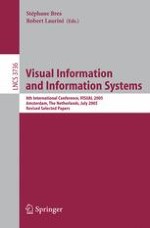Visual Information Systems on the Move Following the success of previous International Conferences of VISual Information Systems held in Melbourne, San Diego, Amsterdam, Lyon, Taiwan, Miami, and San Francisco, the 8th International Conference on VISual Information Systems held in Amsterdam dealt with a variety of aspects, from visual systems of multimedia information, to systems of visual information such as image databases. Handling of visual information is boosted by the rapid increase of hardware and Internet capabilities. Now, advances in sensors have turned all kinds of information into digital form. Technology for visual information systems is more urgently needed than ever before. What is needed are new computational methods to index, compress, retrieve and discover pictorial information, new algorithms for the archival of and access to very large amounts of digital images and videos, and new systems with friendly visual interfaces. Visual information processing, features extraction and aggregation at semantic level and content-based retrieval, and the study of user intention in query processing will continue to be areas of great interest. As digital content becomes widespread, issues of delivery and consumption of multimedia content were also topics of this workshop. Be on the move… June 2005 Stéphane Bres Robert Laurini
